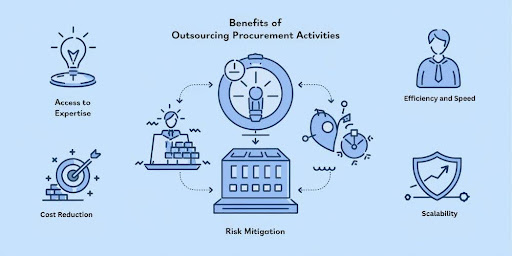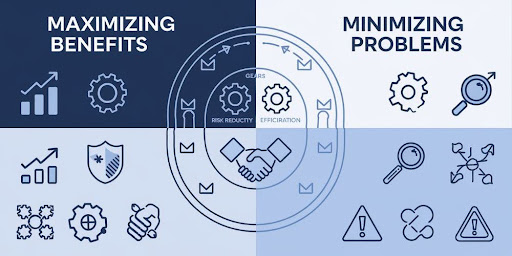
Organizations are continually seeking ways to optimize their operations. One area that has gained significant attention is procurement. Traditionally handled in-house, procurement is now increasingly being outsourced to third-party experts. Outsourcing procurement activities allows businesses to streamline operations, access specialized knowledge, and focus on core functions. However, like any major business decision, outsourcing procurement comes with its own set of challenges.
In this article, we’ll explore the key benefits of outsourcing procurement functions. We’ll also look at the potential problems it may present. By the end, you’ll have a clearer understanding of whether this strategic approach aligns with your business goals and needs.
What Is Procurement Outsourcing?
Procurement outsourcing refers to the practice of delegating certain or all procurement-related activities to an external third-party service provider. These activities can include vendor management, purchasing, contract negotiation, supplier management, and sourcing. Outsourcing is often done to improve performance, reduce costs, and free up internal resources to focus on core business activities.
Benefits of Outsourcing Procurement Activities

The key advantages of outsourcing procurement activities can be summarized as follows:
-
Cost Reduction
One of the primary reasons businesses choose to outsource procurement is to lower costs. External providers typically have more experience, better negotiation power, and established vendor relationships, which can result in better prices for goods and services. Additionally, by outsourcing, companies can avoid the overhead costs associated with maintaining an internal procurement team, such as salaries, benefits, and training.
-
Access to Expertise and Best Practices
Procurement outsourcing firms often have extensive knowledge and expertise in the field. They bring industry best practices and the latest procurement strategies to the table. Many outsourcing providers also have dedicated teams that specialize in specific procurement functions, allowing businesses to leverage that specialized knowledge without having to invest in it internally.
-
Focus on Core Competencies
By outsourcing procurement, companies can focus on their core business activities and strategic goals. Procurement is a time-consuming process that often involves administrative tasks, vendor negotiations, and logistics coordination. When outsourced, these activities can be handled by experts, freeing up internal teams to concentrate on what they do best, such as product development, sales, or customer service.
-
Improved Efficiency and Speed
Procurement outsourcing firms often have established systems and processes in place to ensure efficiency. They use advanced procurement technologies, such as e-sourcing platforms, automated invoicing systems, and supply chain management software, to streamline the process. As a result, procurement activities can be carried out more quickly and accurately, helping businesses reduce lead times and improve overall supply chain performance.
-
Risk Mitigation
By outsourcing procurement to a third party, businesses can transfer some of the risks associated with supply chain management, such as supplier failure or compliance issues, to the outsourcing partner. These providers typically have robust risk management processes and compliance standards, reducing the likelihood of disruptions.
-
Scalability
As a business grows or faces seasonal demand fluctuations, outsourcing procurement can provide scalability. External procurement providers can easily adjust to increased demand without the company having to hire and train additional internal resources. This flexibility is particularly valuable in industries with fluctuating procurement needs.
Problems and Challenges of Outsourcing Procurement

The potential challenges that come with outsourcing procurement functions are outlined below:
-
Loss of Control
One of the major risks of outsourcing procurement is the potential loss of control over the procurement process. When a third party handles purchasing, companies may have less direct oversight and influence over supplier selection, contract terms, and delivery schedules. This lack of control can sometimes lead to issues with quality, delivery delays, or unmet service expectations.
-
Quality Concerns
While outsourcing can help reduce costs, it can also lead to quality issues if not properly managed. If the external provider doesn't align with the company's quality standards or fails to maintain proper supplier relationships, it can result in subpar products or services. Additionally, external procurement teams may be less familiar with the specific needs or standards of the business, which can lead to discrepancies in quality expectations.
-
Hidden Costs
While outsourcing is often seen as a cost-saving measure, there can be hidden costs that companies may not initially foresee. These can include costs for transitioning to an outsourced model, ongoing service fees, or costs related to managing the relationship with the third-party provider. Without careful planning, businesses may find that the total cost of outsourcing is higher than anticipated.
-
Communication Barriers
Effective communication is crucial for the success of procurement activities, and when outsourcing, these lines of communication can sometimes become strained. Time zone differences, language barriers, or cultural misunderstandings can create obstacles to smooth collaboration. Moreover, with a third-party provider handling procurement, there may be delays in communication or misunderstandings regarding requirements and expectations.
-
Security and Confidentiality Risks
Outsourcing procurement typically involves sharing sensitive business data, including supplier contracts, pricing details, and internal cost structures. This raises concerns about data security and confidentiality. If the third-party provider does not adhere to strict security protocols or suffers from a data breach, your business could be exposed to financial or reputational risks. Companies must ensure that their outsourcing partner has robust cybersecurity measures in place.
-
Dependency on the Outsourcing Partner
Relying on a third-party provider for procurement can create a sense of dependency. If the outsourcing partner faces operational issues, financial difficulties, or staffing changes, it can have a direct impact on your procurement operations. This dependency can make it harder to react quickly to changes in the supply chain or shift to alternative suppliers.
-
Cultural and Organizational Misalignment
In some cases, outsourcing can lead to a misalignment in culture and values between the business and its external partner. Procurement outsourcing firms may have different organizational cultures, work processes, or even ethical standards. If not properly managed, this can lead to misunderstandings, delays, or even conflicts between the business and its outsourcing partner.
How to Maximize the Benefits and Minimize the Problems

To make the most of procurement outsourcing, businesses should carefully vet potential providers, clearly define expectations, and maintain open lines of communication. Here are a few tips for success:
-
Choose the Right Provider
Research and select an outsourcing partner with a proven track record and expertise in procurement. Look for providers that align with your company’s values and quality standards.
-
Set Clear Expectations
Establish detailed contracts and service level agreements (SLAs) that outline key performance indicators (KPIs), deliverables, timelines, and responsibilities.
-
Maintain Oversight
While outsourcing allows companies to focus on their core business, it’s important to retain some level of oversight. Regular audits, performance reviews, and communication can help ensure the outsourcing relationship remains productive and aligned with business objectives.
-
Plan for Risk Mitigation
Ensure that your outsourcing partner has a strong risk management process in place. Regularly assess potential risks, including those related to supply chain disruptions, quality control, and cybersecurity.
Optimizing Procurement with SIXM
The decision to outsource procurement depends on your company's specific needs, resources, and long-term goals. Outsourcing can be a powerful tool for optimizing procurement and contributing to overall business success.
At SIXM, we understand the complexity of procurement and the importance of making strategic decisions that align with your business goals. With the right partner, outsourcing procurement can significantly improve your operations and bottom line.
If you're ready to optimize your procurement function and leverage the full potential of outsourcing, SIXM is here to help. We'd like to guide you through the process, making sure you achieve the best outcomes while maintaining control and flexibility in your supply chain.
Outsourcing procurement offers great benefits, but it's important to understand the challenges. Ready to learn more? Get in touch today!

